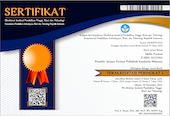Efek Madu Trigona Terhadap Gambaran Histopatologi Ginjal Tikus Putih (Rattus norvegicus) Yang Diinduksi Atorvastatin
Abstract
Trigona honey is produced by the Trigona sp. bee with a high phenolic content which have antioxidant activity. Furthermore the prolonged use and high doses of atorvastatin causes nephrotoxicity side effects. This research aims to determine the effect of trigone honey on the histopathological image of the kidneys of white rat (Rattus norvegicus) induced by atorvastatin at 20 mg/Kg BW for 3 weeks and 40 mg/Kg BW for 2 weeks. Twenty one rats were divided into 7 groups, and each group received different treatment for 5 weeks. The normal control received 0.5% NaCMC, the negative control received atorvastatin, the positive control received CoQ10 at 100 mg/kgBW orally for 2 hours before atorvastatin induction, the honey control received honey at 4.5 mL/kgBW, treatment 1 group was given honey at 1.5 mL/kgBW 2 hours before atorvastatin induction, treatment 2 group was given honey at 3 mL/kgBW 2 hours before atorvastatin induction, and treatment 3 group was given honey at 4.5 mL/kgBW 2 hours before atorvastatin induction. After 5 weeks, surgery was carried out and then observed the histopathological image of the rats' kidneys. The results, based on the evaluation of the tubular and glomerular cell score, showed that the administration of honey trigon at a dose of 4.5 ml/kg light weight protects against kidney damage by the induction of atorvastatin.
Keywords : Statins, Histopathology, Kidney, Trigona Honey
Madu Trigona merupakan madu yang dihasilkan oleh lebah Trigona sp. yang dilaporkan memiliki kandungan fenolik tinggi sehingga memiliki aktivitas antioksidan. Penggunaan atorvastatin dalam jangka waktu yang lama dan dosis tinggi dapat menimbulkan efek samping nefrotoksisitas. Penelitian ini bertujuan untuk mengetahui efek madu trigona terhadap gambaran histopatologi ginjal tikus putih (Rattus norvegicus) yang diinduksi atorvastatin 20 mg/Kg BB selama 3 minggu dan 40 mg/Kg BB selama 2 minggu. Dua puluh satu ekor tikus dibagi menjadi 7 kelompok. Masing-masing kelompok mendapatkan perlakuan berbeda selama 5 minggu. Kontrol normal diberikan NaCMC 0,5%, kontrol negatif diberikan atorvastatin, kontrol positif diberikan CoQ10 100 mg/kgBB secara oral 2 jam sebelum induksi atorvastatin, kontrol madu diberikan madu 4,5 mL/kgBB, kelompok perlakuan 1 diberikan madu 1,5 mL/kgBB 2 jam sebelum induksi atorvastatin, kelompok perlakuan 2 diberikan madu 3 mL/kgBB 2 jam sebelum induksi atorvastatin, dan kelompok perlakuan 3 diberikan madu 4,5 mL/kgBB 2 jam sebelum induksi atorvastatin. Setelah pemberian selama 5 minggu, dilakukan pembedahan kemudian dilakukan pengamatan gambaran histopatologi ginjal tikus. Hasil penelitian berdasarkan penilaian skor sel tubulus dan sel glomerulus menunjukkan bahwa pemberian madu trigona pada dosis 4,5 mL/kgBB memberikan perlindungan terhadap kerusakan ginjal yang disebabkan oleh induksi atorvastatin.
Kata Kunci : Statin, Histopatologi, Ginjal, Madu Trigona
Full Text:
PDF (Bahasa Indonesia)References
Annigeri, R. and Mani, R. (2015) ‘Acute interstitial nephritis due to statin and its class effect’, Indian Journal of Nephrology, 25(1), pp. 54–56. doi: 10.4103/0971-4065.136883.
Arany, I. et al. (2017) ‘Coenzyme Q10 protects renal proximal tubule cells against nicotine-induced apoptosis through induction of p66shc-dependent antioxidant responses’, Apoptosis, pp. 220–228. doi: 10.1007/s10495-016-1309-3.
Banjarnahor, S. D. S. and Artanti, N. (2014) ‘Antioxidant properties of flavonoids’, Medical Journal of Indonesia, 23(4), pp. 239–244. doi: 10.13181/mji.v23i4.1015.
Beltowski, J. (2008) ‘Statins and Modulation of Oxidative Stress’, Toxicology Mechanisms, pp. 61–92.
Ishikawa, A. et al. (2011a) ‘Renal preservation effect of ubiquinol, the reduced form of coenzyme Q10’, Clinical and Experimental Nephrology, 15(1), pp. 30–33. doi: 10.1007/s10157-010-0350-8.
Ishikawa, A. et al. (2011b) ‘Renal preservation effect of ubiquinol, the reduced form of coenzyme Q10’, Clinical and Experimental Nephrology, 15(1), pp. 30–33. doi: 10.1007/s10157-010-0350-8.
Lindsey, A. et al. (2020) Atorvastatin - lindsey. Available at: https://www.ncbi.nlm.nih.gov/books/NBK430779/.
Mamada, S. S. et al. (2018) ‘Pengaruh Suplementasi Madu Trigona terhadap Parameter Fungsi Hati dan Ginjal Tikus Albino (Rattus norvegicus) yang Diberikan Simvastatin’, Jurnal Farmasi Galenika (Galenika Journal of Pharmacy) (e-Journal), 4(1), pp. 36–43. doi: 10.22487/j24428744.2018.v4.i1.9960.
Marantika, A. (2015) ‘Efek Madu Terhadap Gambaran Mikroskopik Ginjal yang Diinduksi Boraks’, Majority, 4(November), pp. 37–40.
Marques, A. et al. (2018) ‘Coenzyme Q10 or Creatine Counteract Pravastatin-Induced Liver Redox Changes in Hypercholesterolemic Mice’, Frontiers in Pharmacology, p. 685. doi: 10.3389/fphar.2018.00685.s003.
Mathur, N., Ramasubbu, K. and Mann, D. L. (2008) ‘Pleiotropic effects of statins’, Heart Failure Clinics, pp. 153–161. doi: 10.1016/j.hfc.2008.01.007.
Mendes, P., Robles, P. G. and Mathur, S. (2014) ‘Statin-induced rhabdomyolysis: A comprehensive review of case reports’, Physiotherapy Canada, 66(2), pp. 124–132. doi: 10.3138/ptc.2012-65.
Nayak, S. and Jindal, A. (2015) ‘Myoglobinuria and Acute Kidney Injury’, Journal of Integrative Nephrology and Andrology, 2(2), p. 50. doi: 10.4103/2225-1243.155775.
Ndagu, L., Berata, I. and Gde Arjana, A. (2013) ‘Madu Berefek Protektif Terhadap Infiltrasi Sel Radang Dan Perdarahan Ginjal Akibat Induksi Aspirin’, Indonesia Medicus Veterinus, 2(1), pp. 102–114.
Petejova, N. and Martinek, A. (2014) ‘Rhabdomyolysis (CC 2014)’, Petejova and Martinek Critical Care, pp. 1–8.
Rao, P. V. et al. (2016) ‘Biological and therapeutic effects of honey produced by honey bees and stingless bees: A comparative review’, Brazilian Journal of Pharmacognosy. Sociedade Brasileira de Farmacognosia, 26(5), pp. 657–664. doi: 10.1016/j.bjp.2016.01.012.
Salampe, M., Kabo, P. and Djabir, Y. Y. (2018) ‘PENGARUH MADU TRIGONA TERHADAP STRESS OKSIDATIF PADA TIKUS PUTIH (Rattus norvegicus) YANG DIINDUKSI STATIN UNTUK MENCEGAH MIOTOKSISITAS’, Majalah Farmasi dan Farmakologi, 22(2), p. 35. doi: 10.20956/mff.v22i2.5697.
da Silva, I. A. A. et al. (2013) ‘Phenolic profile, antioxidant activity and palynological analysis of stingless bee honey from Amazonas, Northern Brazil.’, Food chemistry, 141(4), pp. 3552–3558. doi: 10.1016/j.foodchem.2013.06.072.
Usman, A. N. et al. (2016) ‘Nutrient Content and pH of Honey Propolis Trigona from Masamba, South Sulawesi Indonesia’, International Journal of Sciences : Basic and Applied Research, 26(3), pp. 246–251.
Vadasery, K. (2015) ‘Phytochemical screening and antioxidant activity of different bee honeys’, Journal of Medicinal Herbs and Ethnomedicine, 1, p. 38. doi: 10.5455/jmhe.2015-07-013.
DOI: https://doi.org/10.32382/mf.v16i2.1667
Refbacks
- There are currently no refbacks.

This work is licensed under a Creative Commons Attribution-NonCommercial-ShareAlike 4.0 International License.
Kontak Editor
Hendra Stevani
Jurusan Farmasi Poltekkes kemenkes Makassar
email : hendra@poltekkes-mks.ac.id

This work is licensed under a Creative Commons Attribution-ShareAlike 4.0 International License.




.png)


